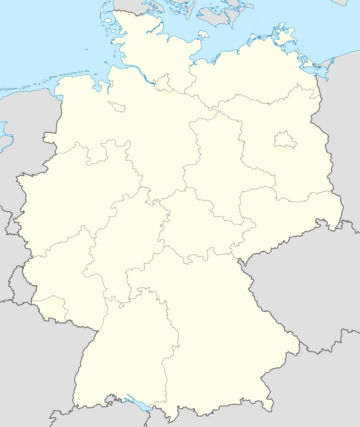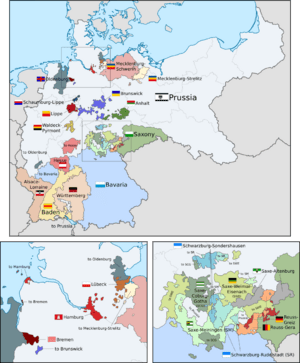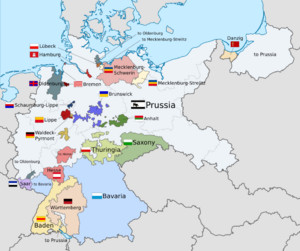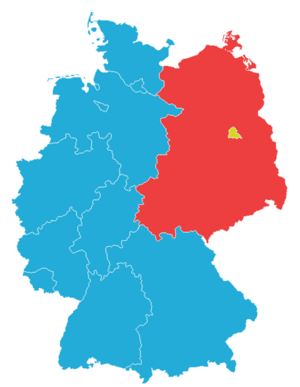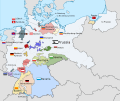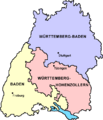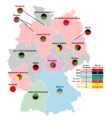States of Germany facts for kids
Quick facts for kids German states |
|
|---|---|
| Category | Federated state |
| Location | Germany |
| Number | 16 |
| Areas | 419.4 km2 (161.92 sq mi) (Bremen) – 70,549.4 km2 (27,239.29 sq mi) (Bavaria) |
| Government | State government |
| Subdivisions | Borough, District, Amt, Governmental district |
Germany is a country made up of sixteen parts called states. In German, these are known as Länder (which means "lands") or Bundesländer (which means "federal states").
Three of these states are actually big cities: Berlin, Hamburg, and Bremen. These are called "city-states." The other thirteen are larger areas, like Bavaria and Saxony. Some of them even call themselves "free states," which is an old term for a republic.
Germany became a country again in 1949 after World War II. It was formed by combining three areas that were controlled by America, Britain, and France. At first, there were fewer states. Over time, some states joined together, like Baden, Württemberg-Baden, and Württemberg-Hohenzollern which became Baden-Württemberg in 1952. In 1957, a region called the Saarland also joined Germany.
A big change happened in 1990 when East and West Germany reunited. Five new states were added: Brandenburg, Mecklenburg-West Pomerania, Saxony, Saxony-Anhalt, and Thuringia. Also, East and West Berlin joined to form one city-state. This brought the total number of German states to sixteen.
Contents
Germany's States: A Closer Look
Germany is a federal state, which means power is shared between the central government and the individual states. The states actually helped create the country we know today.
The idea of "lands" (Länder) has been used in Germany since 1919. Before that, they were called "states" (Staaten). Today, it's common to say Bundesland.
Three states call themselves "free states": Bavaria, Saxony, and Thuringia. This is an old name for a republic and doesn't mean they are more independent today.
Many of the states that existed before World War II have changed. Some merged, and others were divided. For example, the old state of Prussia was split up among several new states.
List of German States
Here is a list of all 16 German states, showing when they were formed, their capitals, and other interesting facts.
| State | State code | Since | Capital | Legislature | Head of state and government (Minister-President or Mayor) |
Bundesrat votes |
Area (km2) |
Pop. (2023-07-01) |
Pop. per km2 | HDI (2021) |
GDP per capita (€; 2020) |
|---|---|---|---|---|---|---|---|---|---|---|---|
| BW | 1952 | Stuttgart | Landtag | Winfried Kretschmann (Greens) | 6 | 35,752 | 11,148,904 | 310 | 0.956 | 45,108 | |
(Bayern) |
BY | 1949 | Munich (München) |
Landtag | Markus Söder (CSU) | 6 | 70,552 | 13,203,592 | 185 | 0.950 | 46,498 |
| BE | 1990 | – | Abgeordnetenhaus | Kai Wegner (CDU) | 4 | 892 | 3,689,708 | 4,086 | 0.959 | 42,221 | |
| BB | 1990 | Potsdam | Landtag | Dietmar Woidke (SPD) | 4 | 29,480 | 2,546,685 | 85 | 0.918 | 29,282 | |
| HB | 1949 | Bremen | Bürgerschaft | Andreas Bovenschulte (SPD) | 3 | 419 | 663,567 | 1,630 | 0.954 | 46,468 | |
| HH | 1949 | – | Bürgerschaft | Peter Tschentscher (SPD) | 3 | 755 | 1,904,212 | 2,439 | 0.972 | 64,022 | |
(Hessen) |
HE | 1949 | Wiesbaden | Landtag | Boris Rhein (CDU) | 5 | 21,115 | 6,313,614 | 297 | 0.950 | 44,750 |
(Niedersachsen) |
NI | 1949 | Hanover (Hannover) |
Landtag | Stephan Weil (SPD) | 6 | 47,609 | 8,045,829 | 168 | 0.930 | 37,005 |
| MV | 1990 | Schwerin | Landtag | Manuela Schwesig (SPD) | 3 | 23,180 | 1,605,259 | 69 | 0.916 | 28,590 | |
(Nordrhein-Westfalen) |
NW | 1949 | Düsseldorf | Landtag | Hendrik Wüst (CDU) | 6 | 34,085 | 17,944,923 | 526 | 0.939 | 38,876 |
(Rheinland-Pfalz) |
RP | 1949 | Mainz | Landtag | Malu Dreyer (SPD) | 4 | 19,853 | 4,126,872 | 206 | 0.929 | 34,673 |
| SL | 1957 | Saarbrücken | Landtag | Anke Rehlinger (SPD) | 3 | 2,569 | 1,005,796 | 386 | 0.931 | 34,125 | |
(Sachsen) |
SN | 1990 | Dresden | Landtag | Michael Kretschmer (CDU) | 4 | 18,416 | 4,036,369 | 221 | 0.933 | 30,903 |
(Sachsen-Anhalt) |
ST | 1990 | Magdeburg | Landtag | Reiner Haseloff (CDU) | 4 | 20,446 | 2,155,742 | 108 | 0.911 | 28,652 |
| SH | 1949 | Kiel | Landtag | Daniel Günther (CDU) | 4 | 15,799 | 2,936,486 | 183 | 0.921 | 33,452 | |
(Thüringen) |
TH | 1990 | Erfurt | Landtag | Bodo Ramelow (The Left) | 4 | 16,172 | 2,099,527 | 133 | 0.923 | 28,953 |
How Germany's States Changed Over Time
Germany has a long history of being made up of many smaller parts. The Holy Roman Empire once had over 300 tiny states! This number was greatly reduced during the Napoleonic Wars. After the Congress of Vienna in 1815, 39 states formed the German Confederation.
Later, in 1867, many northern and central German states joined together to form the North German Confederation. After a war in 1870-71, the southern states joined too, creating the German Empire. This empire had 25 states. The largest and most powerful state was Prussia, which covered about 65% of the land.
After World War I, the German Empire ended. The remaining states became republics in a new German federation called the Weimar Republic. There were discussions about making the states more equal in size, but this didn't happen much.
When the Nazi Party came to power in 1933, they slowly got rid of the states' power. The states became more like simple provinces controlled by the central government.
States After World War II
After World War II, the countries that won the war (the Allies) divided Germany into different zones. They created new states in each zone. They made sure no single state was too big or powerful, to prevent what happened with Prussia before.
For example, Bremen, Hesse, and Bavaria were formed in the American zone. Hamburg and Lower Saxony were in the British zone. In the French zone, states like Rhineland-Palatinate were created. The Soviet zone formed states like Saxony and Thuringia.
When West Germany was founded in 1949, it had eleven states. In 1952, three states in the southwest merged to form Baden-Württemberg. Then, in 1957, the Saarland joined, bringing the total to ten states. These are sometimes called the "Old States" today. West Berlin was also closely connected to West Germany, even though it wasn't officially a state.
There were often talks about changing state borders to make them more efficient. However, most ideas for big changes did not happen because people in the affected areas didn't agree.
German Reunification in 1990
Before 1990, East Germany had been divided into 14 smaller administrative areas. When Germany reunited, the five original states of East Germany were brought back. These are called the "New States." East and West Berlin also joined to form the single state of Berlin.
So, the 10 "old states" plus the 5 "new states" plus the new state of Berlin make up the 16 states of Germany we have today.
After reunification, the German constitution was updated. It confirmed that the 16 states had successfully united Germany. The states also gained more say in matters related to the European Union. There was even a vote in 1996 for Berlin and Brandenburg to merge, but the people of Brandenburg voted against it.
German states can even make agreements with other countries, especially about culture and business, as long as the main German government agrees.
How German States are Governed
Germany is a federal republic, which means it's a country where citizens elect representatives to make decisions. The way Germany is governed is set out in its main law, called the Grundgesetz.
Each state's government must follow democratic principles. Most states are run by a Ministerpräsident (Minister-President) and a parliament called the Landtag. The Minister-President is chosen by the parliament members and is usually the leader of the largest party or coalition. They then pick a team of ministers to help run the state.
In the city-states of Berlin, Bremen, and Hamburg, the government is called a "senate." The head of government in these cities is often called a "Mayor" (like the Governing Mayor in Berlin). Their parliaments have different names, like the Abgeordnetenhaus in Berlin or the Bürgerschaft in Bremen and Hamburg.
How States are Divided
The city-states of Berlin and Hamburg are simply divided into Districts. Bremen is made of two urban districts: Bremen and Bremerhaven. The other, larger states have more layers of local government.
Governmental Districts
Some large states, like Bavaria and North Rhine-Westphalia, are divided into governmental districts (Regierungsbezirke). These are administrative areas that help manage the state's services. Some states have removed these districts to simplify their administration.
Administrative Districts
Below the governmental districts (or directly under the state in others) are administrative districts called Kreise. There are two types:
- Rural districts (Landkreise): These are larger areas that include many smaller towns and villages.
- District-free cities (Kreisfreie Städte): These are large cities that manage their own affairs, like a district.
Germany has over 400 districts in total. Each district has an elected council and a leader who oversees local government. They handle things like roads, hospitals, and public services.
Some areas are special combinations of rural districts and district-free cities, created to make administration simpler.
Local Communities
The smallest administrative units in Germany are the municipalities (Gemeinden). Every district is divided into municipalities. Cities and towns are also municipalities. There are over 12,000 municipalities in Germany! They range from huge cities like Berlin (with almost 3.8 million people) to tiny villages with fewer than 10 residents.
Municipalities are run by elected councils and a mayor. They are responsible for local services like schools, public health, and social help. They also work to improve their local economy and support cultural activities. Most of their money comes from the state or federal government, not just local taxes.
Some parts of Germany are "unincorporated areas." These are usually unpopulated forests or mountains that don't belong to any municipality. A few of these areas do have a small number of people living in them.
Images for kids
-
The Kingdom of Prussia (light gray) within the German Empire (1871–1918)
-
West Germany (blue) and East Germany (red) and West Berlin (yellow)
See also
 In Spanish: Estado federado (Alemania) para niños
In Spanish: Estado federado (Alemania) para niños


